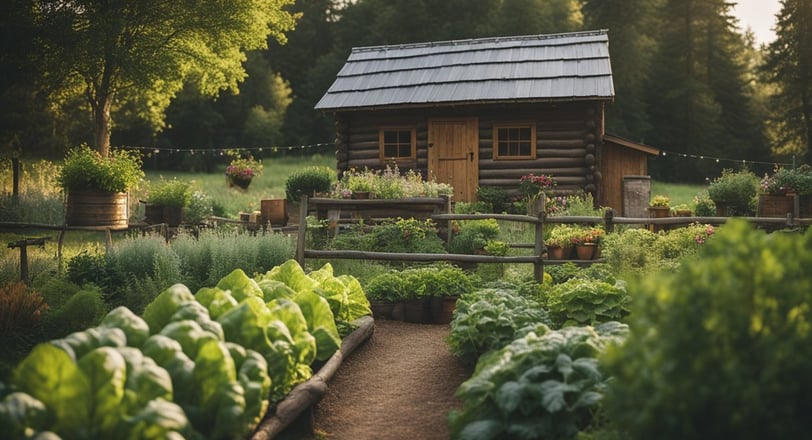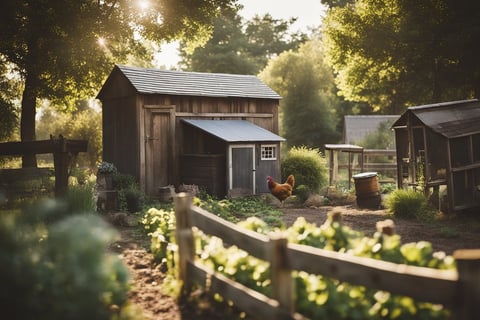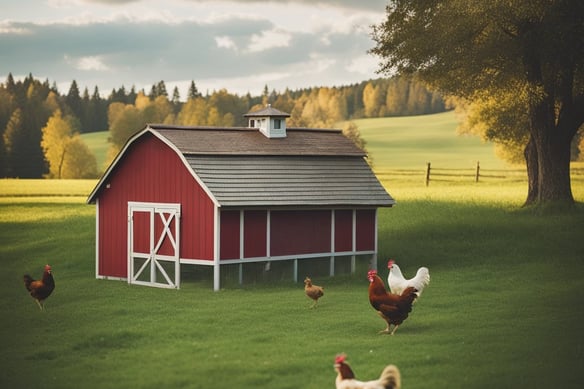Homesteading for Beginners: Essential Tips for Starting Your Self-Sufficient Journey
2/20/202511 min read


Homesteading is an enriching lifestyle choice that many are exploring today. It combines self-sufficiency with a deep connection to nature. For beginners, understanding the basic principles of homesteading can transform a simple backyard into a sustainable haven.
Starting with gardening and small livestock can make the journey manageable and rewarding. Learning how to grow food and raise animals fosters a sense of accomplishment and reliance on personal efforts. Simple practices, such as preserving food and conserving resources, are essential skills every beginner should develop.
As interest in sustainability grows, homesteading offers a practical solution to modern challenges. It encourages individuals to take control of their food sources and reduce dependency on commercial products. By embracing a homesteading mindset, beginners can enjoy a fulfilling and environmentally-friendly lifestyle.
What Is Homesteading?
Homesteading is a lifestyle movement focused on self-sufficiency and sustainability. Individuals embrace various practices to grow their own food, raise livestock, and reduce reliance on commercial systems.
The Benefits Of A Self-Sufficient Lifestyle
Choosing a self-sufficient lifestyle provides multiple advantages.
Cost Savings: Growing food at home significantly reduces grocery bills. The initial investment in seeds and plants often pays off quickly.
Healthier Living: Homegrown produce is typically fresher and free from harmful chemicals. Individuals can control how their food is grown and what substances are used.
Environmental Impact: Reducing reliance on industrial agriculture decreases carbon footprints. Homesteaders often use organic practices, contributing to soil health and biodiversity.
Community Connection: Homesteading can foster a sense of community. Many individuals engage in local exchanges, sharing surplus goods and knowledge.
This lifestyle promotes independence and resilience, making it attractive to many people.
Who Can Start Homesteading? (It’s Not Just For Rural Living!)
Homesteading is accessible to a wide range of individuals, not just those in rural areas.
Urban Homesteaders: People living in cities can convert backyards, balconies, or rooftops into productive spaces. Container gardening, vertical gardening, and small-scale livestock (like chickens) are viable options.
Suburban Creatives: A suburban setting offers space for traditional gardening and small farms. Many residents take advantage of larger plots of land for orchards or vegetable patches.
DIY Enthusiasts: Individuals with a passion for making things can dive into sewing, canning, or woodworking. These skills complement the homesteading lifestyle by promoting self-sufficiency.
Regardless of location, anyone can pursue aspects of homesteading in a manner that suits their lifestyle and space availability.
Step 1: Start Small & Set Your Goals
Starting a homesteading journey requires a clear understanding of personal goals and resources. By beginning with manageable projects, newcomers can build skills and confidence over time.
Understanding What Homesteading Means To You (Gardening, Raising Animals, Preserving Food, Etc.)
Homesteading can encompass a variety of activities including gardening, raising livestock, and food preservation. Each individual may find different aspects appealing. For instance, someone may focus on growing vegetables in a small plot, while another might prioritize canning fruits from their garden.
To clarify personal interests, consider making a list of preferred activities. Questions like "Do you want a vegetable garden or fresh eggs from chickens?" can guide choices. Identifying what resonates most will create a more fulfilling homesteading experience.
Setting Realistic Goals Based On Your Space, Time, And Budget
Setting achievable goals is crucial for success in homesteading. The initial step is assessing available space, time, and budget. For instance, a small yard may limit livestock options but allow for container gardening.
When establishing goals, prioritize short-term objectives that lead to longer-term success. For example, starting with one simple garden bed can pave the way for expansion later. It's essential to balance ambitions with actual resources to avoid frustration.
Learning New Skills Gradually
Homesteading involves a continuous learning process. Newcomers should tackle skills one at a time to avoid feeling overwhelmed. For instance, someone might first learn to plant and care for a garden before moving on to preserving food.
Consider taking workshops or joining local homesteading groups to gain practical knowledge. Online resources also offer various tutorials. Progressing at a comfortable pace ensures retention and mastery of each skill, contributing to overall success in the homesteading journey.
Step 2: Growing Your Own Food
Beginner homesteaders can find joy and satisfaction in growing their own food. This step focuses on cultivating a vegetable and herb garden, understanding soil health, and exploring companion planting.
Starting A Vegetable And Herb Garden (Best Crops For Beginners)
When starting a garden, selecting the right crops is essential. Beginner-friendly vegetables include:
Lettuce: Quick to grow, ideal for salads.
Radishes: Fast-growing, ready to harvest in weeks.
Carrots: Sown directly in the soil, they need minimal care.
Herbs: Basil, cilantro, and mint thrive in small spaces.
Planting these crops in spring or early summer will maximize success. Beginners should consider using raised beds for improved drainage and control over soil quality. A well-planned garden layout can enhance productivity and reduce pest issues.
Understanding Soil Health, Composting, And Natural Fertilizers
Healthy soil is the foundation of a productive garden. It is essential to test soil pH and nutrient levels. Adding organic matter, such as compost, can improve soil structure and fertility.
Composting involves collecting kitchen scraps and yard waste. This process not only reduces waste but also creates nutrient-rich fertilizer. Beginners should use:
Brown materials: Dry leaves, cardboard, and paper.
Green materials: Vegetable scraps, grass clippings, and coffee grounds.
Natural fertilizers, like bone meal and fish emulsion, provide essential nutrients without harmful chemicals. Maintaining soil health encourages robust plant growth and resilience against pests.
Companion Planting And Organic Gardening Practices
Companion planting is an effective strategy for maximizing garden space and promoting healthy growth. Certain plants can benefit each other. For example:
Tomatoes and basil: Basil enhances the growth and flavor of tomatoes.
Carrots and onions: These crops can deter pests when planted together.
Organic gardening practices focus on sustainability and environmental health. Use natural pest control methods, such as neem oil or insecticidal soap, to protect crops. Avoid synthetic chemicals to promote a balanced ecosystem in the garden. Regular observation and care can lead to a thriving garden that provides fresh produce.
Step 3: Preserving & Using Your Harvest
Effective preservation techniques help maintain the flavor, nutrition, and quality of garden produce. Proper methods can reduce waste and enhance meal options throughout the year. Here are some essential techniques for preserving and utilizing your harvest.
Basics Of Canning, Pickling, And Fermenting
Canning involves sealing food in jars and heating them to kill bacteria. This process is crucial for long-term storage. She can choose between water bath canning and pressure canning based on the acidity of her produce.
Pickling, on the other hand, uses vinegar or brine to preserve vegetables. It creates a tangy flavor and prolongs shelf life. Fermenting utilizes beneficial bacteria to convert sugars into acids, adding distinctive tastes.
Examples of popular items include:
Canned tomatoes
Pickled cucumbers
Fermented sauerkraut
Safety is paramount, so using tested recipes from reliable sources is advised to prevent foodborne illnesses.
Freezing And Dehydrating Produce
Freezing is a quick method for preserving freshness. Vegetables like peas and zucchini freeze well, especially when blanched before freezing. Using airtight containers or freezer bags prevents freezer burn.
Dehydrating removes moisture from fruits and vegetables, extending shelf life without refrigeration. Devices such as dehydrators or an oven set on low temperatures work effectively. Dried fruits make excellent snacks, while herbs maintain flavor for cooking.
Common items suitable for freezing and dehydrating include:
Frozen berries
Dehydrated tomatoes
Dried herbs like basil or oregano
Both methods retain the nutrients in the produce, making them beneficial for later use.
Making Homemade Pantry Staples Like Jams, Sauces, And Dried Herbs
Creating homemade pantry staples is a satisfying way to use excess harvest. Jams require fruits, sugar, and pectin. They can be stored in jars and provide a delicious spread for toast or desserts.
Homemade sauces can include tomato sauce, pesto, or salsa. These enhance meals and utilize seasonal produce effectively. Recipes vary widely, allowing for customization in flavors.
Dried herbs, like thyme or rosemary, can be made by air-drying or using a dehydrator. They bring additional flavor to cooking and provide a natural way to preserve garden herbs.
Maintaining a well-stocked pantry adds convenience and enjoyment to cooking year-round.
Step 4: Raising Animals (Optional But Rewarding!)
Raising animals can significantly enhance a homesteader's self-sufficiency and joy. While it requires commitment, the benefits such as fresh produce and companionship are compelling.
Backyard Chickens For Fresh Eggs
Backyard chickens are one of the most popular choices for home poultry. They provide a reliable source of fresh eggs. A typical laying hen produces about 5-6 eggs per week.
To start, a small flock of 3-6 hens suffices for a family. Chickens require a secure coop and a designated run. Proper care includes feeding them a balanced diet and ensuring they have clean water.
Common chicken breeds for beginners include Leghorn, Rhode Island Red, and Cochin. These breeds are known for their hardiness and egg production. Regular health checks help identify any issues early.
Raising Goats Or Cows For Milk And Dairy
Goats and cows offer substantial dairy options. Goats are often easier for beginners; a single dairy goat can produce 1-2 quarts of milk daily. They require less space than cows and are generally more manageable.
Dairy cows can yield 6-8 gallons of milk each day, but they need more land and care. Breeds such as Nubian and Saanen are popular for goats, while Jersey and Holstein are favored for cows.
Both goats and cows need a balanced diet rich in nutrients. It's essential to have a clean shelter and access to pasture for grazing. Regular milking and health care are critical for optimal milk production.
Beekeeping For Honey And Pollination Benefits
Beekeeping is an increasingly popular venture with numerous benefits. Honey bees can produce 30-60 pounds of honey annually. Additionally, they significantly contribute to pollinating crops and gardens.
To start, a beginner should invest in a sturdy hive and appropriate protective gear. The Langstroth hive is a common choice for new beekeepers. It's crucial to monitor the hive regularly for signs of disease or pests.
Beekeepers must keep a close eye on the colony's health and honey production. Local sources for bee packages and specialized classes can aid new beekeepers. This hobby offers rewards beyond honey, fostering a deeper connection with nature.
Step 5: Sustainable Living & Self-Sufficiency
Sustainable living is essential in homesteading, promoting self-sufficiency and reducing reliance on external resources. Focusing on waste reduction, efficient water use, and creating homemade products can significantly enhance a homesteader's lifestyle.
Reducing Waste And Repurposing Materials
Reducing waste is a cornerstone of sustainable living. Homesteaders can implement practices like recycling, composting, and reusing materials found on-site.
Composting: Transform kitchen scraps and yard waste into nutrient-rich compost for gardens.
Repurposing: Items like glass jars can serve as storage or plant containers. Old pallets can be converted into furniture.
Balancing consumption and repurposing helps minimize landfill contributions while maximizing available resources.
Harvesting Rainwater And Composting
Rainwater harvesting is an effective strategy for sustainable water use. By collecting rainwater from roofs, homesteaders can irrigate gardens and reduce water bills.
Installation: Utilize barrels or tanks to store rainwater. Ensure proper filtration to eliminate debris.
Composting: Alongside rainwater, composting enriches the soil. By combining greens (nitrogen-rich materials) and browns (carbon sources), rich soil amendments can be created.
Implementing both practices encourages efficient use of natural resources while fostering a thriving homestead ecosystem.
Making Homemade Cleaning And Personal Care Products
Creating homemade cleaning and personal care items reduces reliance on commercial products filled with chemicals. Simple ingredients often found at home can be used effectively.
Cleaning Products: Vinegar, baking soda, and essential oils can clean surfaces and freshen air. For example, a mixture of vinegar and water cleans glass.
Personal Care: Body scrubs and lotions can be crafted from natural oils and sugars. This approach minimizes chemical exposure and supports skin health.
Embracing these practices can lead to a healthier living environment while promoting a self-sufficient lifestyle.
Step 6: Learning Essential Homesteading Skills
Acquiring practical skills is vital for successful homesteading. Mastering specific crafts and techniques enhances self-sufficiency and fosters a deeper connection with the homesteading lifestyle.
DIY Home Repairs And Woodworking
Basic home repair skills can save money and increase safety. She should start with understanding how to fix leaks, patch drywall, and troubleshoot electrical issues. These repairs require simple tools like a hammer, screwdriver, and pliers.
Woodworking skills allow for building and repairing furniture and structures. Familiarity with saws, drills, and sanders enables the creation of custom pieces. She should consider taking a woodworking class or using online resources for guidance. Joining a community of homesteaders can also provide valuable knowledge and support.
Baking Bread And Making Homemade Dairy Products
Baking bread is a fundamental skill in homesteading. She can begin with basic recipes using flour, water, yeast, and salt. Experimenting with different grains and techniques can lead to unique flavors and textures.
Making homemade dairy products like yogurt, cheese, or butter further enhances self-sufficiency. To make yogurt, she needs milk, a starter culture, and a way to maintain warmth. Cheese-making involves curds and whey, which can be done with simple ingredients. Instructions for these processes are readily available through books and online tutorials.
Herbal Remedies And Natural Medicine
Knowledge of herbal remedies can enhance health and well-being. She should start with identifying common medicinal plants such as chamomile, peppermint, and echinacea. Learning the properties of these herbs is essential for effective use.
Creating tinctures, teas, and salves from herbs is straightforward. Dried or fresh herbs can be extracted in alcohol or infused in oils. This knowledge allows for natural healing options and reduces reliance on commercial products, promoting health and sustainability.
Step 7: Building A Homesteading Community
Creating a supportive community is essential for any beginner homesteader. Engaging with others helps share resources, knowledge, and a sense of belonging that enhances the homesteading experience.
Connecting With Other Homesteaders Online And Locally
Online platforms are a great starting point for connecting with fellow homesteaders. Websites such as Reddit, Facebook groups, and specialized forums provide spaces for discussions, advice, and sharing experiences. Local community boards or agricultural extension offices often host homesteading events or workshops.
In-person meetups create opportunities for networking and collaboration. Attend farmers' markets, homesteading fairs, or local gardening clubs to build relationships. These connections can lead to valuable collaborations and friendships that enhance the homesteading journey.
Trading And Bartering Homegrown Goods
Trading and bartering can be beneficial for homesteaders looking to expand their resources. Fresh produce, homemade products, and livestock can be exchanged within the community. This exchange system fosters goodwill and strengthens community ties.
For example, one can trade excess vegetables for homemade jams or crafts. Creating a neighborhood barter network increases sustainability, as it reduces reliance on cash transactions and fosters local economies. Clear communication about needs and offers ensures successful exchanges.
Learning From Experienced Homesteaders And Sharing Knowledge
Learning from seasoned homesteaders accelerates the knowledge-gathering process. They can provide insights on successful methods, troubleshooting, and local challenges that new homesteaders might face.
Participating in workshops or farm tours allows beginners to see practical applications of homesteading techniques. Additionally, sharing knowledge helps cement one's understanding. Hosting workshops or writing articles for community newsletters can also establish them as a resource and strengthen community bonds.
Conclusion
Homesteading offers a fulfilling lifestyle filled with opportunities for self-sufficiency. Beginners can thrive by focusing on their unique circumstances and embracing a learning mindset.
Encouragement For Beginners To Start Where They Are
Starting a homesteading journey does not require a large plot of land or extensive resources. Beginners should assess their current situation and identify small, manageable projects to kick off their homesteading experience.
For example, growing herbs on a windowsill or keeping a few chickens in a backyard can provide immediate satisfaction. It is essential for newcomers to recognize that every small effort contributes to a more sustainable lifestyle.
Crafting a timeline for projects can help organize tasks, making the journey less daunting.
Emphasizing Progress Over Perfection
In homesteading, progress is far more valuable than perfection. Beginners should aim for actionable steps rather than waiting to achieve ideal conditions.
Learning as they go allows individuals to adapt and improve their techniques over time. Documenting successes and failures helps track growth and reinforces learning experiences.
Additionally, connecting with local homesteading communities can provide valuable support. Sharing tips and experiences can make the learning process enjoyable and less isolating.
Final Tips For A Rewarding Homesteading Journey
To maximize the homesteading experience, beginners should prioritize planning and research. Knowledge about local climate, soil conditions, and seasonal cycles can significantly influence outcomes.
They should also invest in essential tools gradually, focusing on quality over quantity. Starting with the basics—like gardening tools or simple kitchen appliances—will lay a solid foundation.
Finally, maintaining flexibility and a positive attitude will enhance the journey. Homesteading is a lifestyle that evolves, and adaptability is key to long-term success.






Harvest
Explore gardening tips, recipes, and pantry ideas.
Disclaimer
© 2025. All rights reserved.
Our blog is reader-supported. When you buy through links on our site, we may earn an affiliate commission
